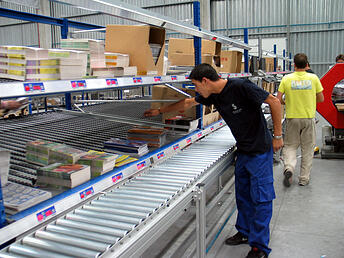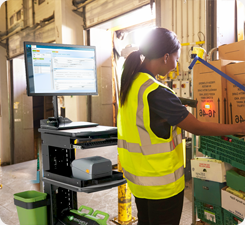
Picking errors are the not-so-silent killer of warehouse productivity. All warehouses know that these mistakes are happening. But not enough businesses understand the gravity of the issue or know how to address it.
Order picking is a process that supports the order fulfillment process. When a customer order arrives, someone has to “pick” that product from the shelves so that it can be packaged and shipped. This is such a major undertaking that it accounts for roughly 55% of a warehouse’s overall operating expenses.
But, when humans are involved, there is the potential for errors. And those mistakes can be costly in more ways than one. Picking error rates in the average warehouse run as high as 3%. Warehouse picking errors impact not only your bottom line but also customer satisfaction. Just one picking error can erode customer trust and reduce the profitability of an order by up to 13%.
Understanding the consequences of picking errors won’t make them go away. But it’s good motivation to look for solutions. Here are five best practices your warehouse can implement to improve picking accuracy and reduce errors.
1. Maintain Accurate Inventory Data
 No strategy for improving the accuracy of your picking activities will be effective without a strong foundation built on timely and accurate data. Specifically, you need a way to easily identify products and locate them quickly with rack labels and internal signage. There should also be a way to verify, in real-time, that the inventory you have is located in the right place, so you don’t run out of stock or risk workers pulling items from the wrong shelves.
No strategy for improving the accuracy of your picking activities will be effective without a strong foundation built on timely and accurate data. Specifically, you need a way to easily identify products and locate them quickly with rack labels and internal signage. There should also be a way to verify, in real-time, that the inventory you have is located in the right place, so you don’t run out of stock or risk workers pulling items from the wrong shelves.
One of the best ways to accomplish this is by using a combination of a warehouse management system (WMS) and RFID tags. A WMS is a tool that manages all aspects of your warehouse’s activities, including inventory management. RFID tags are now being used by many warehouses as a replacement for, or complement to, barcodes. RFID labels are encoded with unique identifiers and can be scanned remotely and in bulk. These give you real-time inventory data, virtually eliminating the chance of a routine mistake or mismatch.
2. Analyze Product Velocity
 It wouldn’t make sense to have products that don’t sell very often in the front of your storage racks and the most popular items in the back or on the top shelves. When it comes to order picking, you’ll want to carefully analyze product velocity so that you can “slot” your products strategically.
It wouldn’t make sense to have products that don’t sell very often in the front of your storage racks and the most popular items in the back or on the top shelves. When it comes to order picking, you’ll want to carefully analyze product velocity so that you can “slot” your products strategically.
“Slotting” refers to how inventory is located within a picking area. Many warehouses use velocity-based sotting, which takes into account how frequently certain products leave the warehouse.
If a picker is required to walk a hundred yards multiple times a shift to get the same item over and over because it is popular, your warehouse layout probably isn’t optimized. Workers will get fatigued, and mistakes will happen. Analyze your product velocity, travel time, and other factors to situate this frequently turned inventory in the right place.
3. Organize Picking Strategically
 In addition to slotting, your inventory and picking strategies should make sense to reduce picking time and improve accuracy. For example, when you group similar items together, they are easier for workers to remember and this improves efficiency. This is referred to as zoning.
In addition to slotting, your inventory and picking strategies should make sense to reduce picking time and improve accuracy. For example, when you group similar items together, they are easier for workers to remember and this improves efficiency. This is referred to as zoning.
In zone picking strategies, order pickers only work in their specific zones. A “hot zone” in a warehouse is a grouping of products that receives the most activity. So, your most accurate pickers should be assigned to these areas.
Batch picking is another common strategy employed that improves accuracy. It can be combined with zone-based warehouse layouts. Using this process, employees pick multiple orders from a certain zone in a single trip. After the trip, the items are separated into their individual orders.
4. Leverage the Right Technology
Not only does adopting the right warehouse technology and automation solutions improve overall profitability. It also reduces fulfillment mistakes. Some of the technologies that are most effective in improving picking accuracy include:

- Radio Frequency Scanning Devices — This is the most widely used order picking solution by a wide margin. These handheld devices remain a flexible and cost-effective way to capture product data.
- Visual Logistics — These handheld devices display text and graphical instructions to the worker to improve the accuracy of their operations. For example, there might be an image of the product or the bin location to use as guidance.
- Pick to Light — Pick to light solutions are designed to improve order picking accuracy by using alphanumeric buttons and displays at storage locations to guide employees in picking activities.
- Voice Directed Picking — With voice-guided picking, employees wear Bluetooth-connected headsets that provide step-by-step audio instructions for picking orders. This hands-free system improves accuracy and increases efficiency.
All of these solutions can be combined with mobile powered carts, bringing everything the workers need to be productive onto the warehouse floor instead of requiring frequent trips back and forth to a central location.
5. Analyze Error Data
Even with the right processes and technology in place, you are likely still going to experience some picking errors. Since your goal is to improve picking accuracy as much as possible, create a system to analyze those errors.
Employees should have assigned IDs so that you can identify any workers that may need additional training. But it’s not fair to always blame the worker. In many cases, you may be able to identify additional opportunities to refine your warehouse organization, change your picking strategies, or adopt new automation solutions that will deliver further gains.
Most warehouse managers understand that customer service is a major driver of their success. And picking errors are going to erode customer satisfaction, which can impact profits and repeat business. Implementing these best practices to improve picking accuracy in your warehouse will help you drive efficiency and give your business a reputation for top-quality service.

|
A Guide to Picking Methods & Performance Enhancements |
